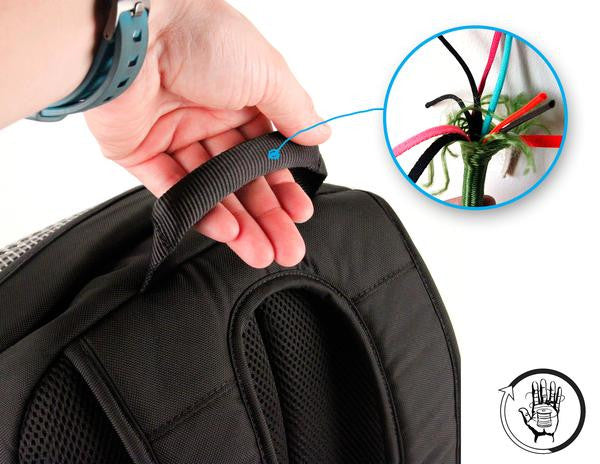What's up everyone, head designer Jake here, reporting live for the tribe from hot and sweaty Saigon. Now that I've been close to the sewing needle and knee deep in THREAD fabrics for about a month now, I figured it'd be a great time to reveal some cool bag related details that you might not know about. A lot of you beautiful people have been getting behind our socially responsible mission, and now more than ever, we've been receiving questions about eco-design considerations and if we take any measures to be responsible in the green way as well. The answer is 'absolutely YES'! Or at least we try our best. Some of them are just buried deep within the bag construction. Here's the inside scoop.

Recently, I made the discovery that a lot of the well-known shoe brands that manufacture here in Saigon (brand names I'll leave out for now, to avoid pointing fingers) have been letting a lot of raw materials go to waste. I figured, why can't we literally 'clean up other peoples messes' and up-cycle the remnants from their production runs and use them in our bags? All bags moving forward will do exactly that! You know that cushy little handle on top of your Wayu or Raja pack?... The core inside that is made from up-cycled shoe laces that are feed into an outer sheeth that is made from recycled polypropelene food sacks (used by local Vietnamese food market vendors for rice and veggies). That colorful little shoe lace sausage is then stuffed inside our tough black nylon tubular webbing where it will live snuggly for the rest if it's baggy life. Cool huh?!

You know those fancy little woven labels on the shoulder straps of your Raja or Wayu Pack? Yup, those are wrapped around our own recycled THREAD fabric that is left over from die-cutting THREADs. Because Our THREADs have a tapered shape to them, some fabric has to be scrapped. Not to worry though, it all gets put right back into the bags. Yeah!

Also, did you know that little recycled label-loop doubles as a sunglass holder or pen slot? Try it, it really works!

When the sewing workers prepare the die-cut THREAD panels to be sewn, a small slot has to be cut out of the fabric to sew in the zipper, which creates tiny slivers of wastage. The newest idea is to make those into bracelets. Would you be into em if we did?

Wastage....

Recycled for her....

Recycled for him...
The buck doesn't stop there though. We go to great lengths in our international THREAD sourcing to make sure we partner with artisans that use only all natural fibers and dyes and are minded in the ways of responsibly sourcing and discarding excess the same way we do.

All base fabric for the embroidered Hmong textiles from Sapa & Bac Ha of Northern Vietnam are made from hemp, which grows wild in the region. They also use all-natural indigo dyes in most of their base textiles. The tell tale signs of this are blue stained finger nails.

All printed and woven textiles are made from 100% locally grown cotton. Our weavers in India get their's from Kerala in the south because it is too hot and arid in the Kuch Desert Region. Our Cham weavers in Vietnam grow their cotton in and around the village, and Indonesian cotton is sourced from Sulawesi and then shipped to Java for Batik processing.

Vegetable dyes are used on the neutral tone THREADs like, India 8, Indonesia 2, 3, 4, 5 & 6, and Vietnam 1, 2, 3 & 4. Warm colors like yellows and light-browns come from onion skins, oranges from orange peel, black comes from burnt & rusted powderized metal, blues come from the Indigo plant, reds come from pomegranate rinds and rhubarb. All pigments are mixed with a chemistry of arabic gum, water and other liquids to create the right viscosity before dying raw yarn. Most natural dyes like this are fermented to bring out color and reduce acidity, which can be hard on the yarn. PH balance is checked regularly with litmus paper to know whether or not the dye is ready to accept yarn. In hot desert villages like Bhuj, our artisans ferment their dyes in large clay pots that are buried under ground to stay cool.

All things considered, our main bags are still made of nylon. This is intentional however, since it is the strongest fabric money can buy and it provides water-resistance and the guarantee that your pack will still be kicking years from now. At the end of the day, your ETHNOTEK bag should last a lifetime and 4x PU coated ballistic nylon is one tough mother! We are currently working on sourcing PET fabrics made from recycled plastic bottles, 50/50 blends to reduce our synthetic consumption by half without jeopardizing strength as well as some coated cotton canvases. All will have to undergo rigorous testing of course, to make sure they meet our quality standards. As you can probably tell, we're big time sticklers on quality and strength and try not to overlook any detail in that department.
Well tribe, that's it from my side, hopefully this answered a few questions and more importantly, sparked some inspiration on how to use and reuse materials in your own process. There's plenty more behind the scenes updates from Team Saigon and our artisans. Stay tuned and active on our Facebook and Twitter to be sure to not miss out on any exciting news coming down the village pipeline.
Stay socially responsible and stay green!
Jake

